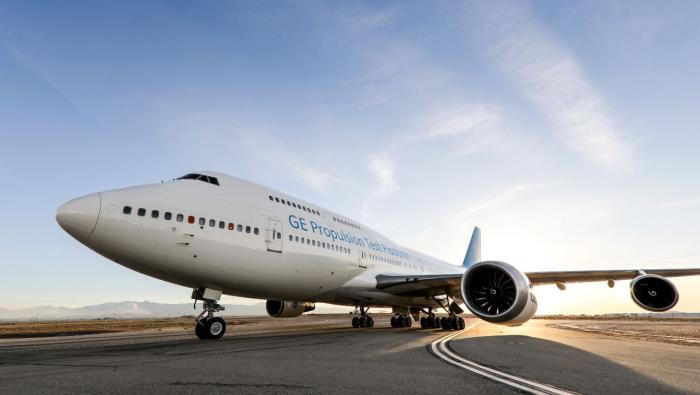
GE Aerospace has teamed up with NASA to gain a better understanding of aircraft contrails through a series of flight tests next week. Under the Contrail Optical Depth Experiment (CODEX), NASA Langley Research Center’s Gulfstream III will trail GE Aerospace’s Boeing 747 flying testbed in flight to study its contrails.
NASA will use light detection and ranging (lidar) technology to scan the contrails behind the 747. Lidar will enable NASA to generate 3D imaging of contrails to provide insight into how they behave.
“Understanding how contrails act in-flight with the latest detection technology is how we move innovation forward. These tests will provide critical insight to advance next-generation aircraft engine technologies for a step change in efficiency and emissions,” said Arjan Hegeman, general manager of future of flight technology for GE Aerospace.
Contrails are created when airplanes fly through cold, humid air, resulting in ice particle clouds. These are believed to have a warming impact on the climate. Industry has been increasingly researching contrails to determine the extent of that impact and whether technology could help reduce non-CO2 emissions.
“NASA is advancing the scientific understanding of contrails to improve our confidence in future operational contrail management decisions that consider overall climate impact and economic trades,” said Rich Wahls, manager of NASA’s Sustainable Flight National Partnership.
|
At NBAA-BACE last month, I was delighted to moderate an aviation maintenance panel that tackled a pressing issue: how to retain talented maintenance professionals in an increasingly competitive industry.
The numbers are sobering. Boeing projects that aviation will need 716,000 new maintenance technicians worldwide over the next 15 years. At the same time, 36% of today’s workforce is nearing or beyond a typical retirement age. So the challenge isn’t just about recruiting new talent; it’s about keeping experienced technicians engaged before they walk out the door.
I had the honor of moderating this discussion alongside four maintenance leaders: Ed Chitren, director of maintenance (DOM) for a Part 91 flight department; Andrew Cosgrove, senior manager of aviation maintenance at Walmart; Bill Hart, Verizon flight department DOM; and Cobi Lane, v-p of production at Duncan Aviation.
Together, we explored challenges and solutions around mentorship, compensation, and work-life balance. We also discussed the role of technology in shaping aviation maintenance.
|
With the first eVTOL aircraft nearing certification, the focus is on how FBO operators are preparing for the integration of advanced air mobility (AAM), panelists said at NATA’s Aviation Business Conference this week in Nashville.
“Some of the biggest challenges for eVTOL development right now are just the uncertainty of what this industry is going to look like,” said Torrie Meliska, manager of infrastructure partnership with airframer Wisk Aero. “Every company has their own idea of what their product is and where it fits, but there still aren’t really solidified regulations around the process of how to [type certify] an eVTOL aircraft.”
“If you were to project out for 15 years, the new technology that we are all going to have to figure out how to incorporate, it’s going to be battery electric first,” added Lydon Sleeper, U.S. strategic policy lead with Joby Aviation. “That’s aircraft like ours, that’s charging systems. How are we going to integrate into the FBO community?”
Atlantic Aviation is one of the service providers already taking measures to upgrade its facilities to be ready for the eventual arrival of AAM. “From an infrastructure perspective, the message that we continually try to hit is to not overcomplicate and make this more than it really is, especially for entry-into-service operations in the next few years,” explained Eric Newman, the FBO chain’s v-p of commercial strategy and sustainability.
|
Sponsor Content: C&L Aviation Group
Has managing all your ERJ landing gear overhauls got you feeling overwhelmed? A third-party provider can assist with the entire process, but is outsourcing right for you? In this resource, C&L Aviation Group explains the benefits of working with a provider for all your ERJ landing gear overhaul management needs.
|
NBAA yesterday announced key changes to its leadership team, including expanded roles for two senior executives and the planned departure of a longtime leader. Jo Damato has been appointed senior v-p of events and professional engagement, while Andrew Broom assumes the position of chief revenue officer. These changes follow the departure of Laurie Lutz, who concluded her tenure as senior v-p of events earlier this month.
“Jo and Andrew are respected and proven leaders with deep experience at NBAA and in the industry,” said NBAA president and CEO Ed Bolen. “We are pleased that they are taking on new responsibilities in support of NBAA’s mission.”
In her expanded role, Damato will oversee the strategic direction of NBAA-BACE, as well as the association's conferences, forums, and professional development initiatives. She retains responsibility for programs including the Certified Aviation Manager credential, scholarships, and sustainability accreditations.
Broom’s new responsibilities include leading exhibit sales for events while continuing to oversee membership, marketing, and sponsorship initiatives. His focus will be on broadening NBAA’s member base, enhancing its brand, and driving revenue growth.
Expressing gratitude to Lutz, Bolen highlighted her contributions, including the successful execution of NBAA-BACE last month.
|
A Part 135 operator case study serves as a cautionary “could have gone terribly wrong” tale for aircraft operators to develop better internal communications, documentation, and operating procedures, Aviation Safety Solutions CEO Amanda Ferraro said this week at Bombardier’s Safety Standdown during her “Into the Danger Zone” presentation.
Ferraro began with a personal anecdote about pushing herself too hard during a Civil Air Patrol training exercise when she was 17. She fainted while on a ropes tower and sustained injuries when she fell. Reflecting on her choices that day and the consequences in her life has strongly influenced what she characterizes as her calling in aviation safety.
She then moved from her personal close call to one illustrated in the Part 135 operator/aircraft management case study and what lessons the operator gleaned from the experience—and what the broader aviation community can learn from it.
The unnamed operator failed to document in writing a maintenance light issue on a smoke detector system for an airplane newly managed by the company, leading to eight subsequent flights with inoperative equipment. The maintenance team determined that the smoke detector was operative, but the maintenance light continued to illuminate.
|
Public transportation in Ireland could be significantly enhanced by new urban and regional air services, according to a new study produced by the Future Mobility Campus Ireland (FMCI) and the Electric Aviation Maven consultancy. The partners published their report yesterday during the Irish Business and General Aviation Association Conference, highlighting how eVTOLs and electric- and hybrid-electric airplanes could provide fresh options for commuting, as well as for wider business and leisure travel.
“Ireland offers a unique opportunity for eVTOL OEMs and operators who will be able to access a market of 89 million travelers annually seeking to undertake business or access diverse historical, cultural, and leisure opportunities across the country,” said EA Maven co-founder Darrell Swanson. “With a potential economic impact of €96 million [$101 million] in time savings from urban air mobility alone, the opportunity is significant.”
According to the joint study, 16 airports across Ireland could be part of a regional air mobility network that would make short flights viable as an alternative to car trips. The report highlights 50 potential domestic routes with a target market of 78 million passengers each year, generating €192 million in economic stimulation through time savings.
“Advanced air mobility has the potential to significantly improve how we sustainably move people and goods across Ireland and its regions,” said Russell Vickers, CEO of FMCI.
|

Photo of the Week
Tailing a comet. Jeffery Cullen snapped this photo from the flight deck of a Thrive Aviation-operated Cessna Citation Sovereign+ as they chased the ATLAS comet at FL450 from Wyoming’s Jackson Hole Airport (KJAC) to McNary Field (KSLE) in Salem, Oregon. The comet was visible in North America from October 14 to 18. Thanks for sharing, Jeffery!
Keep them coming. If you’d like to submit an entry for Photo of the Week, email a high-resolution horizontal image (at least 2000 x 1200 pixels), along with your name, contact information, social media names, and info about it (including brief description, location, etc.) to photos@ainonline.com. Tail numbers can be removed upon request. Those submitting photos give AIN implied consent to publish them in its publications and social media channels.
|
AINalerts News Tips/Feedback:
News tips may be sent anonymously, but feedback must
include name and contact info (we will withhold name on request). We reserve the
right to edit correspondence for length, clarity, and grammar. Send feedback or
news tips to AINalerts editor Chad Trautvetter.
|
AINalerts is a publication of AIN Media Group, 214 Franklin Avenue, Midland Park, New Jersey. Copyright 2024. All rights reserved.
Reproduction in whole or in part without permission is strictly prohibited.
|
|














